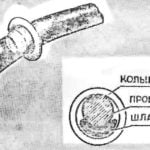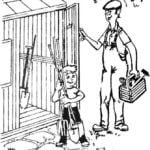The free ends of the bottom stringers and the hull sides are fixed by means of pine bar 20Х50Х400 mm. He, in turn, symmetrically cut into a pattern and fastened by screws on the resin to the keel and groove patterns. The face of the bar having a width of 50 mm, should be at the level of the deck.
Transom plate is attached using four M8 bolts and epoxy resin. To increase the rigidity of the transom we need to make cnico — triangle of a pine bar 40 mm thick with sides: AB = 300 mm, BC = 200 mm, AC = 400 mm. It is sheathed on both sides with plywood 4 mm thick on the screws and resin. Side sun kniza by a screw, and resin attached to the keel, and the side AB is to the plate.
After preparation of the skeleton of the body, one can start the casing. For this purpose, plywood thickness of 4 mm. should Start from the bottom. Each sheet of the perimeter is laid a strip of fiberglass on the resin — to create a seal, the fastening of the sheet — screws, nails Usagi, also on pitch.
The bottom is sheathed in the following manner. First slanted areas, then flat; the sheet for it to be 80 mm wider than the site itself. If there is no right size of plywood separate sheets are joined to the resin edges “on us” and riveted copper nails.
Before proceeding to the deck plating and the nose of hydrocort, you need to glue resin on the inside all the joints, and then another and the strips of fiberglass. After drying, the entire inner surface cover with a waterproof varnish. For easy carry attach with the M6 bolts three handles: two to the transom, one — bar patterns.
Deck plating is done with plywood 4 mm thick for the same technology as the bottom. The inner plane of each sheet pre-coated with a waterproof varnish, excluding the space for the set. For knize cut groove, which, after securing the plywood is glued with fiberglass.
Trim fore end of the two sheets of plywood with a thickness of 4 mm. Each of these parts is attached to edges of strips of patterns to the first frame to the sidewall and bars embedded in the mold. The technology is the same that of the bottom and deck.
![Fig. 2. Theoretical drawing hydrocort (see also table).]()
Fig. 2. Theoretical drawing hydrocort (see also table).
When the entire body is ready, you can take on the manufacture of the box-seat. Plywood 4 mm thick sidewall made, and of pine sticks 20X40 mm frame size 150X290 mm, which screws with the resin is attached to the first frame. In the frame in the transom plate grooves are cut in such a way that they can be stacked two strips 20X20 mm, the upper bound which would be at a height of 150 mm from the deck. The distance between the outer faces of these strips should match the width of the transom plate.
Just below these straps are attached to the deck are the same — turns out the box seats, which are screwed on the screws the plywood sidewall. In the place where the box height goes from 150 mm to 230 mm, a jumper from the pine bar. Another jumper is made of plywood 10X200X290 mm — will serve also to impart stiffness, and as a support shaft of the steering wheel.
Upon completion of all Assembly work, the housing must be cleaned with emery paper and to paste the seams with strips of fiberglass epoxy resin. Then fiberglass or gauze on the resin paste over all the bottom of the deck bow section and the box-seat. Overlap the cloth carefully and thoroughly primatyvajutsja not to leave bubbles, the edges overlap by 20-30 mm. After drying, the whole pasted surface is sanded with abrasive stone.
It remains to make the seat cushion and on the bottom to install the sponsons. Preparing for the cushion frame, the size of which is dictated by the inner perimeter of the box seat. To the frame with screws on the resin is attached to the platform made of plywood 10 mm thickness: together they form a cover for the box. On top of it is covered artificial leather on foam pad — soft seat cushion.
The sponsons are cut from the bar 10X40 mm and have a cross-section of a triangle, the wide face which should be parallel to the bottom. The first step is installed under the projecting edge of the trim flat part of the bottom; the second — stringer, the third to the hull side. They are installed by laying strips of fiberglass cloth on the screws with resin.
REMOTE CONTROL
Manufacturer hydrocort ends up installing remote control outboard motor. It includes a motorcycle wheel, the drum helm, cables, steering and gas throttle, rotary fixture and two rollers. Motorcycle wheel welded to shaft any length of steel pipe Ø 20 mm. On it is fixed a drum made of aluminum or PCB Ø 200 mm and height is based on 2-3 round rope, the diameter of which is equal to 3-4 mm.
At the end of the shaft is mounted a bronze stop and the hole in the jumper seat is enhanced by the bronze ring, which plays a decorative role.
The rotary fixture is a yoke, to which are welded the two wings, all of the steel strips 40 mm wide and 4 mm thick. the total length of the wings should not exceed the diameter of the drum. The clamp is attached to the engine block with bolts M10 at a height that would preclude the misalignment of the steering cable, attached to the wings using lanyards and passes through the rollers 40 mm mounted in l-shaped brackets on the edges of the transom plate.
For fixing the gas cable to the engine must be installed in the bracket in the shape of P from a steel strip of a thickness of 3 mm. For the rope outlet in the engine hood is cut. To ensure self discharge gas is set the spring on the throttle lever. In addition, hydrocort must be equipped with a safety switch that ensures the motor to stop if the driver didn’t keep the seat.
PAINTING
The most recent works and finishing. They are executed in the following order. Acetone or baking soda are degreased body and the parts to be painted. Epoxy or primer PF-00-2 should be filled by bumps, cracks, burrs. After drying and Stripping — a common putty with the same materials. Again drying and Stripping, after which a General primer zinc white, another drying and local podgotovka. The prepared surface is painted with a decorative enamels: pentaftalevyh No. 570, PF-115, glyptal. Then drying, polishing and final coating water-resistant (pentaftalevyh, glyptal) varnish, after which a final drying and polishing.
I. TSYGANKOV, head of the society of hydracarina Donetsk obsut
Recommend to read
 TUBE — OUTSIDE
TUBE — OUTSIDE
Once I took off the rubber hose and clamp under the right hand was not. Then I picked up steel ring of internal diameter slightly greater than the diameter of the hose, and cut a wooden... HOZBLOK-CLAMSHELL
HOZBLOK-CLAMSHELL
What outbuildings do not see in the garden or suburban areas! Most often it is a tiny shed, located at the far end of the site, or a large economic unit, combined with a summer kitchen....
 It was called hydrocardon, although it is more like a kind of water motorcycle. Built is sports microsode the Donetsk regional station of young technicians in the circle of “Small shipbuilding.” As reported in the editorial of the Director of the station N. Vladimir Vasilyev, the club celebrates this year its fifteenth anniversary. Initially, in the classroom young engineers studied the structure and purpose of a variety of sports and pleasure craft, have developed a new design .mostly motor boats. The work aroused great interest guys, but I felt that something still was missing. It soon became clear that the young “shipbuilders” I wanted not only to create a motor court, but also to experience them and more — to compete: whose machine was faster, so, technically perfect.
It was called hydrocardon, although it is more like a kind of water motorcycle. Built is sports microsode the Donetsk regional station of young technicians in the circle of “Small shipbuilding.” As reported in the editorial of the Director of the station N. Vladimir Vasilyev, the club celebrates this year its fifteenth anniversary. Initially, in the classroom young engineers studied the structure and purpose of a variety of sports and pleasure craft, have developed a new design .mostly motor boats. The work aroused great interest guys, but I felt that something still was missing. It soon became clear that the young “shipbuilders” I wanted not only to create a motor court, but also to experience them and more — to compete: whose machine was faster, so, technically perfect.
